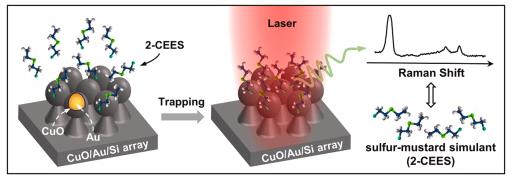Ultrasensitive surface-enhanced Raman spectroscopy detection of gaseous sulfur-mustard simulant based on thin oxide-coated gold nanocone arrays
作者:Xu Wangsheng;Bao Haoming;Zhang Hongwen;Fu Hao;Zhao Qian;Li Yue;Cai Weiping
期刊:JOURNAL OF HAZARDOUS MATERIALS
卷(期)页:卷420
全文链接:https://www.sciencedirect.com/science/article/pii/S0304389421016332?via%3Dihub

期刊:JOURNAL OF HAZARDOUS MATERIALS
卷(期)页:卷420
全文链接:https://www.sciencedirect.com/science/article/pii/S0304389421016332?via%3Dihub

Surface Enhanced Raman Spectroscopy (SERS) could be a powerful technique for detecting trace gaseous sulfur mustard, but it is still challenging due to the difficulty in efficiently capturing sulfur-mustard molecules by normal SERS substrates. Here, a chemically trapping strategy is presented for such detection via coating an ultrathin metal-oxide sensing layer on a SERS substrate. In the strategy, a SERS substrate Au-wrapped Si nanocone array is designed and fabricated by Si wafer-based organic template-etching and appropriate Au deposition, and coated with an ultrathin CuO for chemically capturing sulfur-mustard molecules. The validity of such strategy has been demonstrated via taking the gaseous 2-chloroethyl ethyl sulfide (a simulant of sulfur mustard, or 2-CEES for short) as the target molecules. The response of the CuO-coated SERS substrate to the gaseous 2-CEES is detectable within 10 min, and the lowest detectable concentration is 10 ppb or less. Further experiments have shown that there exists an optimal CuO coating thickness which is about 6 nm. The CuO coating-based capture of 2-CEES molecules is attributed to the surface hydroxyl-induced specific adsorption, which is subject to the pseudo-second-order kinetics and Freundlich-typed model. This study presents the practical SERS chips and new route for the trace detection of gaseous sulfur-mustard.
上一条:Quantitative Surface-Enhanced Raman Spectroscopy for Field Detections Based on Structurally Homogeneous Silver-Coated Silicon Nanocone Arrays
下一条:Raman reporter-assisted Au nanorod arrays SERS nanoprobe for ultrasensitive detection of mercuric ion (Hg2+) with superior anti-interference performances
下一条:Raman reporter-assisted Au nanorod arrays SERS nanoprobe for ultrasensitive detection of mercuric ion (Hg2+) with superior anti-interference performances
